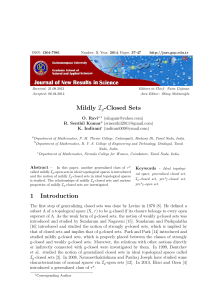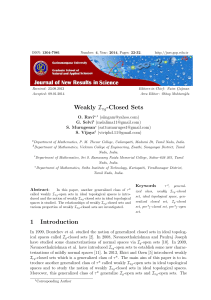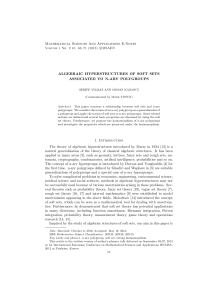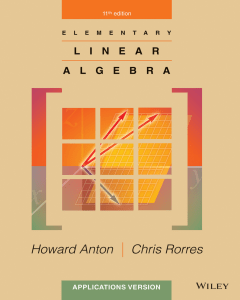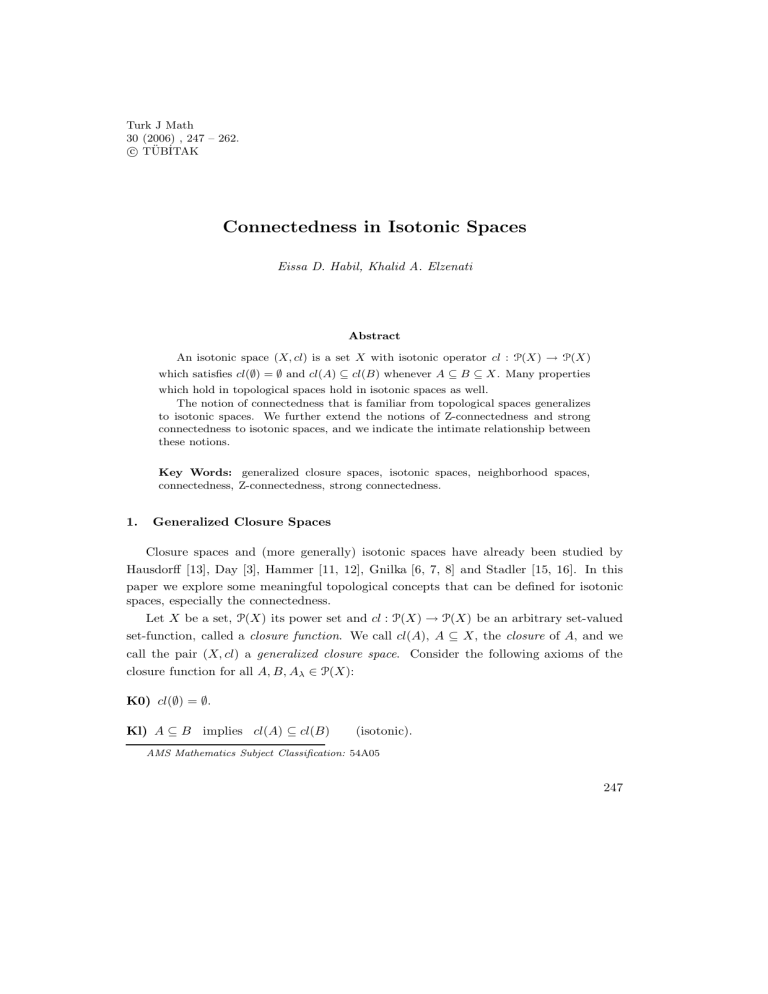
Turk J Math
30 (2006) , 247 – 262.
c TÜBİTAK
Connectedness in Isotonic Spaces
Eissa D. Habil, Khalid A. Elzenati
Abstract
An isotonic space (X, cl) is a set X with isotonic operator cl :
P(X) → P(X)
which satisfies cl(∅) = ∅ and cl(A) ⊆ cl(B) whenever A ⊆ B ⊆ X. Many properties
which hold in topological spaces hold in isotonic spaces as well.
The notion of connectedness that is familiar from topological spaces generalizes
to isotonic spaces. We further extend the notions of Z-connectedness and strong
connectedness to isotonic spaces, and we indicate the intimate relationship between
these notions.
Key Words: generalized closure spaces, isotonic spaces, neighborhood spaces,
connectedness, Z-connectedness, strong connectedness.
1.
Generalized Closure Spaces
Closure spaces and (more generally) isotonic spaces have already been studied by
Hausdorff [13], Day [3], Hammer [11, 12], Gnilka [6, 7, 8] and Stadler [15, 16]. In this
paper we explore some meaningful topological concepts that can be defined for isotonic
spaces, especially the connectedness.
Let X be a set, P(X) its power set and cl : P(X) → P(X) be an arbitrary set-valued
set-function, called a closure function. We call cl(A), A ⊆ X, the closure of A, and we
call the pair (X, cl) a generalized closure space. Consider the following axioms of the
closure function for all A, B, Aλ ∈ P(X):
K0) cl(∅) = ∅.
Kl) A ⊆ B implies cl(A) ⊆ cl(B)
(isotonic).
AMS Mathematics Subject Classification: 54A05
247
HABIL, ELZENATI
K2) A ⊆ cl(A)
(expanding).
K3) cl(A ∪ B) ⊆ cl(A) ∪ cl(B)
K4) cl(cl(A)) = cl(A)
K5)
S
λ∈Λ cl(Aλ )
(sub-additive).
(idempotent).
S
= cl( λ∈Λ (Aλ ))
(additive).
The dual of a closure function is the interior function int : P(X) → P(X) which is defined
by
int(A) := X \ cl(X \ A).
(1)
Given the interior function int : P(X) → P(X), the closure function is recovered by
cl(A) := X \ (int(X \ A)) for all A ∈ P(X).
(2)
A set A ∈ P(X) is closed in the generalized closure space (X, cl) if cl(A)=A holds. It is
open if its complement X \ A is closed or equivalently A = int(A).
It should be noted that the open and closed sets will not play a central role in our
discussion. From now on, (for short) the word space will mean a generalized closure space.
Definition 1.1 [15] Let cl and int be a closure and its dual interior function on X. Then
the neighborhood function N : X → P(P(X)) assigns to each x ∈ X the collection
N(x) := { N ∈ P(X) | x ∈ int(N )}
(3)
of its neighborhoods. A set V is a neighborhood of A, i.e. V ∈ N(A), if V ∈ N(x) ∀x ∈ A.
The proof of the next lemma follows immediately from the definitions.
Lemma 1.1 [15, 16] For any space (X, cl), V ∈ N(A) if and only if A ⊆ int(V ).
The next theorem illustrates the intimate relationship between closures of sets and neighborhoods of points.
Theorem 1.1 [15, 16] Let N be the neighborhood function defined in equ.(3). Then
x ∈ cl(A) if and only if X \ A ∈
/ N(x).
It should be noted that there are equivalent properties for (Ki), i = 0, 1, ..., 5, which can
be expressed in terms of interior or neighborhood functions (see [15, 16, 10]).
248
HABIL, ELZENATI
2.
Isotonic Spaces
Definition 2.1 [15, 16] An isotonic space is a pair (X, cl), where X is a set and cl :
P(X) → P(X) satisfies the axioms (K0) and (K1). An isotonic space (X, cl) that satisfies
(K2) is called a neighborhood space. A closure space is a neighborhood space that satisfies
(K4). A topological space is a closure space that satisfies (K3).
Lemma 2.1 [12, Lemma10] The following conditions are equivalent for an arbitrary
closure function cl : P(X) → P(X):
(K1) A ⊆ B ⊆ X implies cl(A) ⊆ cl(B).
(K1I ) cl(A) ∪ cl(B) ⊆ cl(A ∪ B) for all A, B ∈ P(X).
(K1II ) cl(A ∩ B) ⊆ cl(A) ∩ cl(B) for all A, B ∈ P(X).
It is easy to derive equivalent conditions for the associated interior function by repeated
application of int(A) = X \ cl(X \ A), as the following lemma shows.
Lemma 2.2 [15] The following conditions are equivalent for an arbitrary interior function: int : P(X) → P(X):
(K1III ) A ⊆ B ⊆ X implies int(A) ⊆ int(B).
(K1IV ) int(A) ∪ int(B) ⊆ int(A ∪ B) for all A, B ∈ P(X).
(K1V ) int(A ∩ B) ⊆ int(A) ∩ int(B) for all A, B ∈ P(X).
An isotonic space can be described by means of interior and neighborhood functions, as
the following two lemmas show. Their proofs follow immediately from the definitions
and, therefore, are omitted.
Lemma 2.3 A space (X, cl) is isotonic if and only if the interior function int : P(X) →
P(X) satisfies:
I0) int(X) = X;
I1) int(A) ⊆ int(B) ∀A ⊆ B ⊆ X.
Lemma 2.4 A space (X, cl) is isotonic if and only if the neighborhood function N : X →
P(P(X)) satisfies:
249
HABIL, ELZENATI
N0) X ∈ N(x) ∀x ∈ X;
N1) N ∈ N(x), N ⊆ N1 implies N1 ∈ N(x).
The next theorem shows that (N1)(or equivalently (K1)) is a necessary and sufficient
condition for defining the closure function in terms of neighborhoods.
Theorem 2.1 [3, Theorem 3.1, Corollary 3.2] Let (X, cl) be a space and c(A) := {x ∈
X | ∀N ∈ N(x) : A ∩ N 6= ∅} for all A ⊆ X. Then
(i) c(A) ⊆ cl(A).
(ii) c : P(X) → P(X) is isotonic (i.e., satisfies (K1)).
(iii) c(A) = cl(A) if and only if cl is isotonic.
The following brief study of the lower separation axiom T1 for isotonic and neighborhood
spaces is needed for the study of connectedness in section 5.
0
Definition 2.2 [15, 16] A space (X, cl) is a T1 -space if ∀x, y ∈ X, x 6= y, ∃N ∈ N(x)
00
00
0
/N , y∈
/N .
and N ∈ N(y) such that x ∈
Proposition 2.1 [15] An isotonic space (X, cl) is a T1 -isotonic space if and only if
cl({x}) ⊆ {x} ∀x ∈ X.
In general topology the definition of T1 -topological spaces has several equivalent forms ([5,
Theorem V-1.2], [17, Theorem 13.4]), which can be generalized to neighborhood spaces,
as in the next theorem.
Theorem 2.2 Let (X, cl) be a neighborhood space. Then the following statements are
equivalent:
a) (X, cl) is T1 .
b) Each one-point set in X is closed.
c) Each subset of X is the union of closed sets contained in it.
Proof. Let (X, cl) be a neighborhood space.
250
HABIL, ELZENATI
(a ⇒ b): If (X, cl) is T1 , then, by Proposition 2.1, cl({x}) ⊆ {x} for all x ∈ X. Since,
by (K − 2), {x} ⊆ cl({x}), we have cl({x}) = {x} ∀x ∈ X. Therefore, ∀x ∈ X, {x}
is a closed set.
(b ⇒ c): It is trivial.
(c ⇒ a): If each subset of X is the union of closed subsets contained in it, then it is
2
trivial that {x} = cl{x} ∀x ∈ X. Therefore, by Proposition 2.1, (X, cl) is T1 .
3.
Continuous Functions
The purpose of this section is to define continuous functions on a space (X, cl) with
arbitrary closure function, and establish their elementary properties.
Definition 3.1 [15, 16] Let (X, cl) and (Y, cl) be two spaces. A function f : X → Y
is continuous if cl(f −1 (B)) ⊆ f −1 (cl(B)) ∀B ∈ P(Y ).
Proposition 3.1 [16] Let (X, cl) and (Y, cl) be two spaces and
following statements are equivalent:
f : X → Y . Then the
(1) f is continuous.
(2) f −1 (intY (B)) ⊆ intX (f −1 (B))
(3) B ∈ NY (f(x))
∀B ∈ P(Y ).
implies f −1 (B) ∈ NX (x) ∀B ∈ P(Y ).
Definition 3.2 [15] Let (X, cl) and (Y, cl) be two spaces. We say that f : X → Y is
continuous at x ∈ X if ∀B ∈ P(Y ) and B ∈ NY (f(x)), we have f −1 (B) ∈ NX (x).
Corollary 3.1 [15] Let (X, cl) and (Y, cl) be two spaces. Then f : X → Y is continuous
if and only if it is continuous at every x ∈ X.
Definition 3.3 [15] Let (X, cl) and (Y, cl) be two spaces. Then f : X → Y is closurepreserving if for all A ∈ P(X), f(clX (A)) ⊆ clY (f(A)).
Theorem 3.1 [15] Let (X, cl) and (Y, cl) be isotonic spaces. Then the following properties
are equivalent:
(i) f : X → Y is continuous.
251
HABIL, ELZENATI
(ii) f : X → Y is closure-preserving.
(iii) f(A) ⊆ B implies f(clX (A)) ⊆ clY (B) for all A ∈ P(X) and B ∈ P(Y ).
Lemma 3.1 Let (X, cl) and (Y, cl) be neighborhood spaces and f : X → Y . Then the
following statements are equivalent:
(i) f is continuous.
(ii) clX (f −1 (B)) = f −1 (clY (B)) for all closed sets B ⊆ Y ; i.e., the inverse image of
every closed set in Y is closed in X.
(iii) intX (f −1 (B)) = f −1 (intY (B)) for all open sets B ⊆ Y ; i.e., the inverse image of
every open set in Y is open in X.
Proof.
(i⇒ ii): Suppose f is continuous. Then for all closed sets B in Y , clX (f −1 (B)) ⊆
f −1 (clY (B)). Since, by (K2), f −1 (clY (B)) ⊆ clX (f −1 (clY (B)) = clX (f −1 (B),
it follows that clX (f −1 (B)) = f −1 (clY (B)).
(ii⇒ iii): Suppose (ii) holds. Then for all open sets B in Y , intX (f −1 (B)) = X \ clX (X \
f −1 (B)) = X \ clX (f −1 (Y \ B)) = X \ f −1 (clY (Y \ B)) = f −1 (Y \ clY (Y \ B)) =
f −1 (intY (B)).
(iii⇒ i): Immediate from Proposition 3.1.
2
Lemma 3.2 Let X, Y, Z be spaces and suppose that f : X → Y and g : Y → Z are
continuous functions. Then g ◦ f : X → Z is continuous.
Proof. Let A ⊆ Z. Then (g ◦ f)−1 (clZ (A)) = f −1 (g−1 (clZ (A))) ⊇ f −1 (clY (g−1 (A))) ⊇
clX (f −1 (g−1 (A)) = clX (g ◦ f)−1 (A). Therefore g ◦ f : X → Z is continuous.
252
2
HABIL, ELZENATI
4.
Subspaces
Definition 4.1 [16] Let (X, cl) be a space and Y ⊆ X. Then cY : P(Y ) → P(Y ), A 7−→
Y ∩ cl(A) is the relativization of cl to Y . The pair (Y, cY ) is called a subspace of (X, cl).
If A ⊆ Y then the relative interior of A is given by
intY (A) := Y \ cY (Y \ A) = Y ∩ int(A ∪ (X \ Y ))
and the relative neighborhoods of A are
NY (A) := {N ∩ Y |N ∈ N(A)}.
Definition 4.2 [16] A property B of a space (X, cl) is hereditary if every subspace (Y, cY )
of (X, cl) also has the property B.
The proof of the following lemma is obvious.
Lemma 4.1 The properties (K0) and (K1) are hereditary in any space (X, cl).
Definition 4.3 Let (X, cl) and (Y, cl) be spaces, f : X → Y and A ⊆ X. We will use
f|A to denote the restriction of f to A which is defined by (f|A)(x) := f(x) for each
x ∈ A.
Theorem 4.1 Let (X, cl) and (Y, cl) be isotonic spaces and A ⊆ X. Then (f|A) : A → Y
is continuous, whenever f : X → Y is continuous.
Proof. Let B ⊆ Y . We have cA ((f|A)−1 (B)) = cA (f −1 (B) ∩ A). Since X is isotonic,
by Lemma 2.1, cA (f −1 (B) ∩ A) ⊆ cA (f −1 (B)) ∩ cA (A) = clX (f −1 (B)) ∩ A ∩ cA (A) ⊆
f −1 (clY (B)) ∩ A ∩ cA (A) = (f|A)−1 (clY (B)) ∩ cA (A) ⊆ (f|A)−1 (clY (B)). Hence (f|A) :
A → Y is continuous.
2
5.
Connectedness
Definition 5.1 In an isotonic space (X, cl), two subsets A, B ⊆ X are called semiseparated if cl(A) ∩ B = A ∩ cl(B) = ∅.
Lemma 5.1 [16] In an isotonic space (X, cl), the following two conditions are equivalent
for all A, B ⊆ X:
253
HABIL, ELZENATI
(SS) A, B are semi-separated.
(SS’) There are U ∈ N(A) and V ∈ N(B) such that A ∩ V = U ∩ B = ∅.
Lemma 5.2 [16] Let (X, cl) be an isotonic space and let A, B ⊆ Y ⊆ X. Then A and B
are semi-separated in (X, cl) if and only if A and B are semi-separated in (Y, cY ).
Lemma 5.3 [15] Let (X, cl) and (Y, cl) be spaces and let f : (X, cl) → (Y, cl) be a
continuous function. If A, B ⊆ Y are semi-separated in Y , then f −1 (A) and f −1 (B) are
semi-separated in X.
Definition 5.2 [15] A set Y ∈ P(X) is connected in a space (X, cl) if it is not a disjoint
union of a nontrivial semi-separated pair of sets A, Y \ A, A 6= ∅, Y . We say that a space
(X, cl) is connected if X is connected in (X, cl).
Definition 5.3 Let (X, cl) be a space and x ∈ X. The component C(x) of x in X is the
union of all connected subsets of X containing x.
Definition 5.4 A space (X, cl) is totally disconnected if for each x ∈ X the component
C(x) = {x}.
Theorem 5.1 [15] A set Y ∈ P(X) is connected in an isotonic space (X, cl) if and only
if for each proper subset A ⊂ Y ,
[cl(A) ∩ (Y \ A)] ∪ [cl(Y \ A) ∩ A] 6= ∅.
Topology books [5, 17, 9, 4] define connected spaces by means of open and closed
sets. That definition is equivalent to our definition if and only if the space (X, cl) is a
neighborhood space.
Theorem 5.2 A neighborhood space (X, cl) is connected if and only if there are no
nonempty disjoint open (closed) sets H and K in X with X = H ∪ K.
Proof. Suppose that X is disconnected. Then X = H ∪ K, where H, K are semiseparated, disjoint sets. Since H ∩ cl(K) = ∅, we have cl(K) ⊆ X \ H ⊆ K and then, by
(K2), cl(K) = K. Since cl(H) ∩ K = ∅, a similar argument yields that H is a closed set.
Conversely, suppose that H and K are disjoint open sets such that X = H ∪ K. Now
K = X \ H, and H is an open set, hence K is a closed set. Thus H ∩ cl(K) = H ∩ K = ∅.
254
HABIL, ELZENATI
A similar argument yields that cl(H) ∩ K = ∅. Thus H and K are semi-separated and
therefore X is disconnected.
2
Dugundji [5, Chap.V 1.3] gave an equivalent definition of connectedness by proving
that a topological space X is connected if and only if any continuous function from X
to the discrete space {0, 1} is constant. The next result shows that we can extend this
definition to isotonic spaces by assuming that {0, 1} is a T1 -isotonic space.
Theorem 5.3 An isotonic space (X, cl) is connected if and only if for all T1 -isotonic
doubleton spaces Y = {0, 1}, any continuous function f : X → Y is constant.
Proof. Suppose X is connected, and let f : X → Y be continuous. To show that
f is constant, assume not. Then there is a set A ⊆ X such that A = f −1 ({0}) and
X \ A = f −1 ({1}). Now by continuity and T1 , we have clX (A) = clX (f −1 ({0})) ⊆
f −1 (clY {0}) ⊆ f −1 ({0}) = A, which implies that clX (A) ∩ (X \ A) = ∅. A similar
argument will give A ∩ clX (X \ A) = ∅. Hence we have a contradiction, since X is
connected. Therefore f must be a constant function.
Conversely, suppose X is disconnected. Then there are semi-separated sets A, B ⊆ X
such that A ∪ B = X, and hence cl(A) ⊆ A and cl(B) ⊆ B. Since A ∪ B = X, we have
X \A ⊆ B, which implies, by (K1) and semi-separation of A, B, that cl(X \A) ⊆ cl(B) ⊆
X \A. Take the space (Y, cl) such that Y := {0, 1}, cl(∅) = ∅, cl({0}) = {0}, cl({1}) = {1}
and cl(X) = X. It is clear that the space (Y, cl) is a T1 -isotonic space.
Claim: The function f : X → Y such that f(A) = {0} and f(X \ A) = {1} is
continuous. To see this, let ∅ =
6 C ⊆ Y . Then we have three cases to consider.
Case 1. C = Y . In this case, f −1 (C) = X and hence clX (X) = clX (f −1 (C)) ⊆ X =
f −1 (C) = f −1 (cly (C)), since Y = clY (Y ).
Case 2. C = {0}. In this case, f −1 (C) = A and hence clX (A) = cl(f −1 (C)) ⊆ A =
f −1 (C) = f −1 (clY (C))
Case 3. C = {1}. In this case, f −1 (C) = X \ A and hence clX (X \ A) = cl(f −1 (C)) ⊆
X \ A = f −1 (C) = f −1 (clY (C)).
Thus the function f is continuous but not constant. This proves the claim, and hence
the theorem.hfill2
255
HABIL, ELZENATI
The importance of Theorem 5.3 lies in the fact that it can be used as a test for
proving connectedness for subsets of isotonic spaces, as can be seen from the proofs of
the following results.
Theorem 5.4 If f : (X, cl) → (Y, cl) is a continuous function between isotonic spaces,
and X is connected, then f(X) is connected in Y .
Proof. Let g : f(X) → {0, 1} be a continuous function, where {0, 1} is a T1 -isotonic
space. Since f is continuous, then, by Lemma 3.2, g ◦ f : X → {0, 1} is continuous
and hence, by connectedness of X, it is constant. Thus g is constant and therefore, by
Theorem 5.3, f(X) is connected.
2
Remark 5.1 Since every neighborhood space is an isotonic space, we see that our
Theorem 5.4 generalizes Theorem 18 of [15] for neighborhood spaces.
Theorem 5.5 If (X, cl) is an isotonic space and A ⊆ X, then cl(A) is connected whenever A is connected and A ⊆ cl(A).
Proof. Let f : cl(A) → {0, 1} be a continuous function, where {0, 1} is a T1 -isotonic
space. Then, by Theorem 4.1, f|A : A → {0, 1} is continuous. Since A is connected,
then, by Theorem 5.3, f|A is constant; say f(A) = {a} for some a ∈ {0, 1}. Hence, by
Theorem 3.1 and Proposition 2.1, we have f(cl(A)) ⊆ cl{0,1} (f(A)) = cl{0,1} ({a}) ⊆ {a}.
Thus f : cl(A) → {0, 1} is constant, and therefore, by Theorem 5.3 again, cl(A) is
connected.
2
Remark 5.2 It should be noted that our Theorem 5.5 yields Theorem 17 of [15] and
a similar result in other cited references as an immediate corollary (see Corollary 5.1
below).
Corollary 5.1 [5, 17, 15, 9, 4] If (X, cl) is a neighborhood space and Z ⊆ X, then cl(Z)
is connected whenever Z is connected.
The following lemma appears in [15, Lemma 11]. We give a different proof which is based
on Theorem 5.3.
Lemma 5.4 [15] If Y and Z are connected sets in an isotonic space (X, cl) and Y ∩Z 6= ∅,
then Y ∪ Z is connected.
256
HABIL, ELZENATI
Proof. Let f : Y ∪ Z → {0, 1} be a continuous function, where {0, 1} is a T1 -isotonic
space. Then, by Theorem 4.1, f|Y and f|Z are continuous functions and hence, by
Theorem 5.3, each is constant, since Y and Z are connected. Since Y ∩ Z 6= ∅, then
f : Y ∪ Z → {0, 1} is constant, and therefore, by Theorem 5.3, Y ∪ Z is connected.
2
Lemma 5.5 Let A1 , A2 , ..., An be connected subsets of an isotonic space (X, cl) such
S
that Ai ∩ Ai+1 6= ∅ for all i = 1 to n − 1. Then Ai is connected.
Proof. It follows easily from Lemma 5.4 and induction.
2
Lemma 5.6 Let {Aλ | λ ∈ Λ} be a family of connected subsets of an isotonic space
S
T
(X, cl) such that λ∈Λ Aλ 6= ∅. Then λ∈Λ Aλ is connected.
Proof. Let x0 ∈
T
λ∈Λ
Aλ be fixed and let f :
S
λ∈Λ
Aλ → {0, 1} be a continuous
function, where {0, 1} is a T1 -isotonic space. Then, by Theorem 4.1, f|Aλ : Aλ → {0, 1}
is continuous for all λ ∈ Λ. Since Aλ is connected for all λ ∈ Λ, then, by Theorem 5.3,
f|Aλ is constant for all λ ∈ Λ, and hence f({x0 }) = f(Aλ ) for all λ ∈ Λ. Thus the
S
S
function f : λ∈Λ Aλ → {0, 1} is constant and therefore, by Theorem 5.3, λ∈Λ Aλ is
connected.
2
Theorem 5.6 If (X, cl) is an isotonic space with the property that for any distinct points
x, y ∈ X there exist connected subsets A1 , A2 , ..., An such that x ∈ A1 , y ∈ An and
Ai ∩ Ai+1 6= ∅ for all i = 1, 2, ..., n − 1, then X is connected.
Proof. Fix x ∈ X. Then, by hypothesis, for each y ∈ X \ {x} there are connected subsets
A1y , A2y , ..., Any such that x ∈ A1y , y ∈ Any and Aiy ∩A(i+1)y 6= ∅ for all i = 1, 2, ..., n−1.
Sn
By Lemma 5.5, we have By := i=1 Aiy is connected. Since x ∈ A1y for all y ∈ X \ {x},
S
then x ∈ By for all y ∈ X \ {x}. Therefore, by Lemma 5.6, y6=x By = X is connected.2
Remark 5.3 It should be noted that Lemma 5.6 generalizes Lemma 2 of [2] and Theorem 5.6 generalizes Theorem 1 of [2]
257
HABIL, ELZENATI
6.
Z-Connected Isotonic Spaces
Definition 6.1 [1] Let (Z, cl) be an isotonic space with more than one element. An
isotonic space (X, cl) is called Z-connected if and only if any continuous function f :
X → Z is constant.
Lemma 6.1 If Z is a neighborhood space with more than one element, then every Zconnected isotonic space is connected.
Proof. Let (X, cl) be a Z-connected isotonic space, and let f : X → {0, 1} be a
continuous function, where {0, 1} is a T1 -isotonic space. Since Z is a neighborhood space
and has more than one element, then there exists a continuous injection g : {0, 1} → Z.
By Lemma 3.2, g ◦ f : X → Z is continuous. Hence g ◦ f is constant, since X is Zconnected. It follows that f is constant, and therefore, by Theorem 5.3, X is connected.
2
Lemma 6.2 Any continuous image of a Z-connected isotonic space is Z-connected.
Proof. Let (X, cl) be a Z-connected isotonic space, (Y, cl) be an isotonic space, f :
X → Y be a continuous surjection , and g : Y → Z be a continuous function. Then
g ◦ f : X → Z is continuous, and hence, by Z-connectedness, g ◦ f is constant. It follows
that g is constant and therefore Y is Z-connected.
2
Lemma 6.3 Let {Aλ | λ ∈ Λ} be a family of Z-connected subsets of an isotonic space
S
T
(X, cl) such that λ∈Λ Aλ 6= ∅. Then λ∈Λ Aλ is Z-connected.
Proof. The proof is similar to the proof of Lemma 5.6.
2
Theorem 6.1 If (X, cl) is an isotonic space with the property that for any distinct points
x, y ∈ X there exist Z-connected subsets A1 , A2 , ..., An such that x ∈ A1 , y ∈ An and
Ai ∩ Ai+1 6= ∅ for all i = 1, 2, ..., n − 1, then X is Z-connected.
Proof. The proof is similar to the proof of Theorem 5.6.
2
Theorem 6.2 If Z is a totally disconnected neighborhood space, then Z-connectedness
for isotonic spaces is equivalent to connectedness.
258
HABIL, ELZENATI
Proof. Let X be an isotonic space. By Lemma 6.1, if X is Z-connected, then it is
connected. Conversely, if X is connected, then, by Theorem 5.4, for any continuous
function f : X → Z, f(X) is connected. Since Z is totally disconnected, f must be
constant, and therefore X is Z-connected.
2
7.
Strongly Connected Isotonic Spaces
Definition 7.1 A space (X, cl) is strongly connected if there is no countable collection
S
of pairwise semi-separated sets {Ai } such that X = Ai .
Lemma 7.1 A strongly connected isotonic space is connected.
Proof. It is immediate from Definition 5.2 and Definition 7.1.
2
It should be noted that the converse of Lemma 7.1 is false, as the following example
shows.
Example 7.1 Let X = {a, b, c} and define cl : P(X) → P(X) as follows: cl(∅) =
∅ , cl(X) = X, cl({a}) = {a}, cl({b}) = {b}, cl({c}) = {c}, cl({a, b}) = X, cl({a, c}) =
X, cl({b, c}) = X. It is easy to check that X is a connected isotonic space. However, X
is not strongly connected, since there are pairwise semi-separated sets {a}, {b} and {c}
such that X = {a} ∪ {b} ∪ {c}.
Lemma 7.2 A continuous image of a strongly connected isotonic space is strongly connected.
Proof. Let f : (X, cl) → (Y, cl) be a continuous function between isotonic spaces and
suppose f(X) is not strongly connected. Then there exists a countable collection of pairS
wise semi-separated sets {Ai } such that f(X) = Ai . Since f −1 (Ai ) ∩ clX (f −1 (Aj )) ⊆
f −1 (Ai ) ∩ f −1 (clY (Aj )) = ∅ for all i 6= j, then the collection {f −1 (Ai )} is pairwise semiseparated. Thus we have a contradiction since X is strongly connected. Therefore f(X)
is strongly connected.
2
Theorem 7.1 An isotonic space (X, cl) is strongly connected if and only if it is Zconnected, for any countable T1 -isotonic space (Z, cl).
259
HABIL, ELZENATI
Proof. Suppose (X, cl) is strongly connected but not Z-connected for some countable
T1 -isotonic space (Z, cl). Then there exists a continuous function f : X → Z which is not
constant, and hence B := f(X) is a countable set with more than one element. Now for
S
each bi ∈ B there is Ai ⊆ X such that Ai = f −1 ({bi }), and hence X = Ai . Since f is
continuous and Z is (T1 ), then for each i 6= j, Ai ∩clX (Aj ) = f −1 ({bi })∩clX (f −1 ({bj })) ⊆
f −1 ({bi }) ∩ f −1 (clZ ({bj })) ⊆ f −1 ({bi }) ∩ f −1 ({bj }) = ∅, contradicting the strong connectedness of X. Therefore X is Z-connected.
Conversely, Suppose X is Z-connected for any countable T1 -isotonic space (Z, cl) ,
but X is not strongly connected. Then there exists a countable collection of pairwise
S
semi-separated sets {Ai } such that X = Ai . Now consider the space (Z, cl), where Z is
the set of integers and cl : P(Z) → P(Z)is defined by clZ (B) = B for each B ⊆ Z. Clearly
(Z, cl) is a countable T1 -isotonic space. Fix A0 ∈ {Ai }.
Claim: The function f : X → Z such that f(A0 ) = {a} and f(X \ A0 ) = {b} where
a, b ∈ Z and a 6= b is continuous.
To see this, note that since clX (A0 )∩Ai = ∅ for all i 6= 0, we have clX (A0 )∩
S
i6=0
Ai =
6 B ⊆ Z. Then we have three cases:
∅, and hence clX (A0 ) ⊆ A0 . Let ∅ =
Case 1. a, b ∈ B. In this case, f −1 (B) = X and hence clX (f −1 (B)) = clX (X) ⊆ X =
f −1 (B) = f −1 (clZ (B)).
Case 2. a ∈ B and b ∈
/ B. In this case, f −1 (B) = A0 and hence clX (f −1 (B)) =
clX (A0 ) ⊆ A0 = f −1 (B) = f −1 (clZ (B)).
Case 3. b ∈ B and a ∈
/ B. In this case, f −1 (B) = X \ A0 . Since clZ (B) = B for
S
each B ⊆ Z, we have intZ (B) = B for each B ⊆ Z. Now X \ A0 ⊆ i6=0 Ai ⊆
X \ clX (A0 ) = intX (X \ A0 ). Hence, f −1 (intZ (B)) = X \ A0 = f −1 (B) ⊆
intX (X \ A0 ) = intX (f −1 (B)).
Thus, by Proposition 3.1, f is continuous. This proves the claim. Since f is not constant,
we have a contradiction to the Z-connectedness of X. Therefore X is strongly connected.2
Lemma 7.3 Let {Aλ | λ ∈ Λ} be a family of strongly connected subsets of an isotonic
S
T
space (X, cl) such that λ∈Λ Aλ 6= ∅. Then λ∈Λ Aλ is strongly connected.
260
HABIL, ELZENATI
2
Proof. The proof is similar to the proof of Lemma 5.6.
Theorem 7.2 If (X, cl) is an isotonic space with the property that for any distinct points
x, y ∈ X there exist strongly connected subsets A1 , A2 , ..., An such that x ∈ A1 , y ∈ An
and Ai ∩ Ai+1 6= ∅ for all i = 1, 2, ..., n − 1, then X is strongly connected.
2
Proof. The proof is similar to the proof of Theorem 5.6.
References
[1] Bo, D., Yan-loi, W.: Strongly Connected Spaces. Department of Mathematics, National
University of Singapore, 1999.
[2] Brandsma, H.: Connectedness I. Topology Atlas, Topology Explained, pp. 1, November
2003.
[3] Day, M. M.: Convergence, closure an neighborhood. Duke Math. J., 11, 181–199 (1994).
[4] Deshpands, J. V.: Introduction to Toplogy. Tata McGraw-hill Publishing company Limited,
1988.
[5] Dugundji, J.: Topology. Wm. C. Brown Publishers, 1989.
[6] Gnilka, S.: On extended topologies I: Closure operators. Ann. Soc. Math. Pol., Ser. I,
commented. Math. 34, 81-94 (1994).
[7] Gnilka, S.: On extended topologies II: Compactness, quasi-metrizability, symmetry. Ann.
Soc. Math. Pol., Ser. I, commented. Math. 35, 147-162 (1995).
[8] Gnilka, S. : On continuity in extended topologies. Ann. Soc. Math. Pol., Ser. I, commented.
Math. 37, 99-108 (1997).
[9] Kelley, J: General Topology. Springer-Verlag NewYork Heidelberg Berlin, 1955.
[10] Kent D. C., Won-Keum Min: Neighborhood spaces. IJMMS 32:7, 387-399 (2002).
[11] Hammer, P. C.: Extended topology: Continuity I. Portug. Math. 25,77-93 (1964).
[12] Hammer, P. C.: Extended topology: Set-valued set functions. Nieuw Arch. Wisk. III. 10,
55-77 (1962).
[13] Hausdorff, F.: Gestufte raume. Fund. Math. 25, 486-502 (1935).
261
HABIL, ELZENATI
[14] Pisani, C.: Convergence in exponentiable spaces. Theory and Applications of Categories 5.
No. 6, 148162 (1999).
[15] Stadler, B. M. R., Stadler, P. F.: Basic properties of closure spaces. J. Chem. Inf. Comput.
Sci. 42, 577-585 (2002).
[16] Stadler, B. M. R., Stadler, P. F.: Higher separation axioms in generalized closure spaces.
Commentationes Mathematicae Warszawa, Ser. I. 43, 257-273 (2003).
[17] Willard, S.: General Topology. Addsion-Wesley Publishing Company, Inc, 1970.
Eissa D. HABIL, Khalid A. ELZENATI
Department of Mathematics
Islamic University of Gaza
P. O. Box 108
Gaza, Palestine
e-mail: [email protected]
e-mail: [email protected]
262
Received 10.12.2004


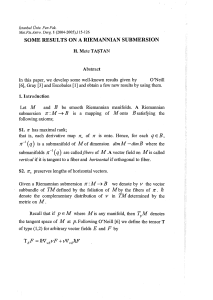
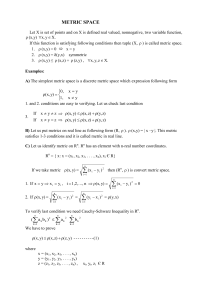
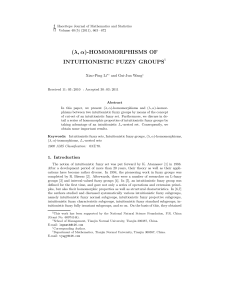
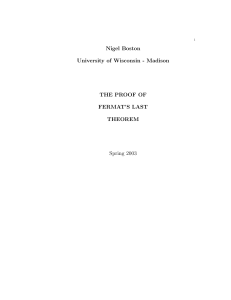
![[Erwin Kreyszig] Introductory Functional Analysis (BookFi.org)](http://s2.studylibtr.com/store/data/005904596_1-634324ffec1bfeb41b79d5ca75ede5d4-300x300.png)
